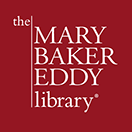Early stories of Christian Science in Michigan
By Elise McCurties
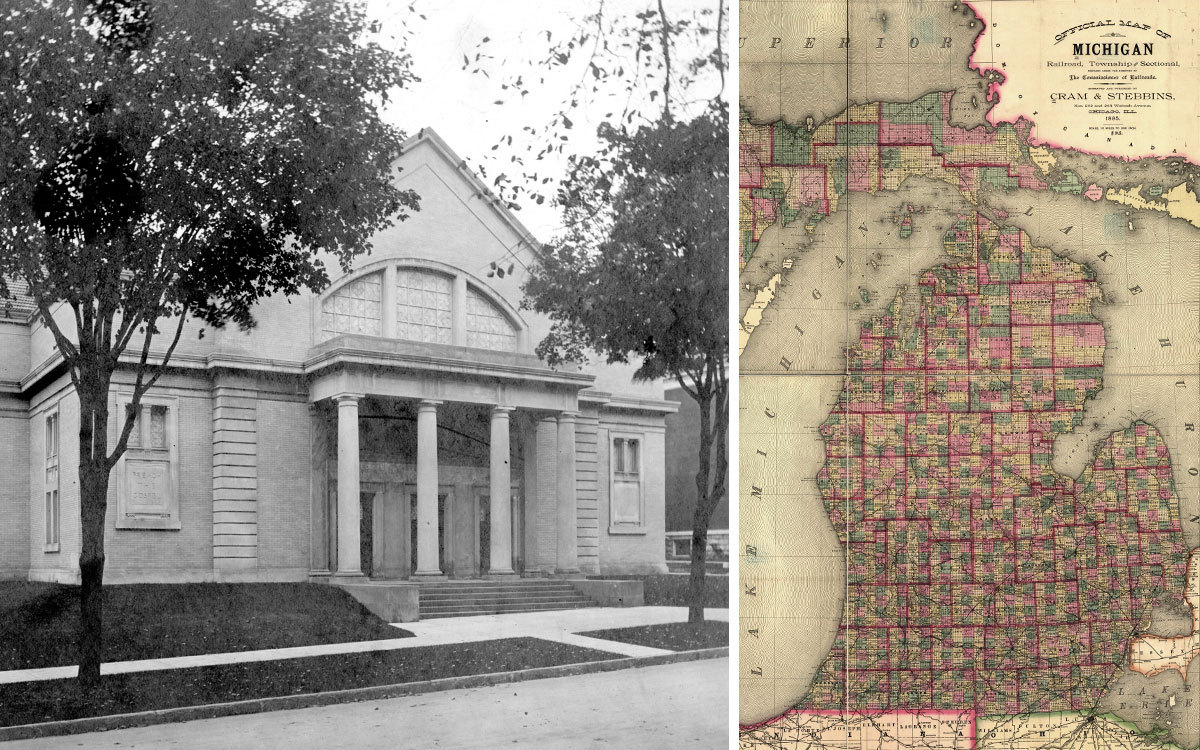
Exterior of First Church of Christ, Scientist, Grand Rapids, Michigan, circa 1906. Unknown photographer. Courtesy of FCCS, Grand Rapids. Church Archives, Box B530759, Folder F232943; Map of Michigan, 1885. Courtesy of Library of Congress, Geography and Map Division, G4110 1885 .C7.
“Man longs, through life’s dark day of pain, / For one ‘far-off divine event.’” Those words are from a poem by Charles H. Barlow, which was adapted for use as Hymn 391 in the Christian Science Hymnal. It asks:
Why search the future and the past?
Why do ye look with tearful eyes
And seek far off for paradise?
Before your feet Life’s pearl is cast.1
When Barlow penned his poem in 1888, Christian Science had indeed become for him “Life’s pearl.” And he wasn’t alone in his conviction that Mary Baker Eddy’s religious discovery was the answer to his prayers and solution to his problems. Across the state of Michigan, from Barlow’s rural village of LeRoy to the bustling city of Detroit, people suffering from lives of hardship and illness also believed Christian Science might be their means of deliverance. These seekers sent pleas for aid to a woman they’d never met, and most likely whose theology they barely understood—but whose promise of help and proven track record of healing through prayer had sparked hope. The nascent faith in this new religion meant these letters weren’t just despairing recitations of deprivation. Instead they were threaded with an undercurrent of cautious optimism. Could Christian Science be their “Life’s pearl,” too?
From a sampling of Michiganders’ letters written to Eddy in 1885 and 1886, one sees the variety of individual yearning for help—and the variety of ways she supplied aid.2 For some it was through words of comfort, a complimentary copy of The Christian Science Journal, or a Christian Science practitioner’s contact information.3 For others (if enough community members also showed interest), one of Eddy’s trusted students from the Massachusetts Metaphysical College (MMC) might relocate to the area. Like the neophyte searching for healing answers, those well-taught missionaries also depended on Eddy’s counsel as they corresponded about the challenges and victories of healing in the early church.4 From reading exchanges between Eddy and her trailblazing MMC graduates—as well as her correspondence with interested Midwesterners—one gets a glimpse of the courage and resolve required to establish Christian Science in Michigan.
In addition, many letters came from newcomers with scant knowledge.5 Martha Bates was one writer from Traverse City, Michigan. She didn’t even know the proper term for the new religion. But the little she had heard of it made her “anxious to know how to know more.” Though she guessed at Eddy’s mailing address, Bates closed her inquiry on an expectant note: “I send this floating waif of a letter hoping sincerely that it may reach you.”6
In comparison to Bates, other writers already owned Eddy’s book Science and Health with Key to the Scriptures and wrote to request instruction at the MMC.7 Mattie Bowen of the south central Michigan city of Hillsdale, for example, was convinced from her study of Science and Health that Christian Science was her “only hope of ever being well – or able to do any good in this world.”8 And she wanted to take a class from Eddy in Boston.
Like many interested in studying with the woman who discovered Christian Science, taking a course would be no small feat. Bowen had four young children. Her husband was antagonistic toward the new religion. Neighbors believed her interest in it indicated she was “going crazy.” Moreover, her family’s financial situation was perpetually dire. She wasn’t alone, in fact—many writers told Eddy about the financial strain and unsupportive relatives hindering them. In response to these descriptions of adversity, Eddy often sent back encouraging words and offered a steep discount on class tuition.9
Despite the heavy homefront resistance, determined individuals were unswayed. In Bowen’s case, the chronic invalid traveled alone to Boston in 1885, in an effort to meet Eddy and enroll in the MMC. Achieving only the former goal, she returned in frustration to her disapproving husband and that August began a letter-writing campaign to secure admission in the next class. Over a four-month period, Bowen wrote to Eddy repeatedly, begging for a spot. And while her resolve was unwavering, at times Bowen’s increasingly difficult homelife and her disappointment in the delay seeped into her correspondence. After receiving another deferment that October, Bowen wrote, “you are very Dear to me — notwithstanding you have almost — Ignored – My Existence.”10 In her closing lines, stern resolve triumphed over petulance, and Bowen declared that if given the choice to take class or have one million dollars, she “should without hesitation – Say – I will Study with Mrs Eddy.”11
Finally, on November 1, 1885, the dogged Bowen received her MMC acceptance notification. In a letter of gratitude to Eddy, Bowen shared her reaction:
You will never know– how Surprised–& rejoiced I was to get your letter–this morning telling me the good news I’ve waited So long to hear…did I Sing or Shout for Joy “ah no,” my Joy was too deep for that. I cried as hard as if I had received the news of the death of a dear Friend- only there would be the difference of crying for Joy ….12
Bowen took the class later that month. Like many who studied with Eddy at MMC, she quickly started a successful healing practice after returning home, which was documented in the Journal.13 Letters from Hillsdale residents described how Bowen’s example inspired other people’s interest in Christian Science—so much so that they purchased Science and Health for their friends.14 As a result of these successful outreach efforts, the area’s growing interest in Christian Science was featured in the Journal’s “Reports from the Field.”15
While Bowen had desired to learn directly from Eddy at the MMC, other Midwesterners requested that a teacher be sent to them. In early 1885, Michigan had just one MMC-trained Christian Scientist, the newly arrived Sarah J. Clark in Detroit. Clark’s move was welcome news to Detroiters, who had asked that an established Christian Scientist be sent to “one of the most beautiful and desirable places of residence in the country.”16 A week into her stay, Clark wrote to Eddy about the need for someone to join her, explaining there was a great deal of receptivity to Christian Science, as well as misteaching about it.17
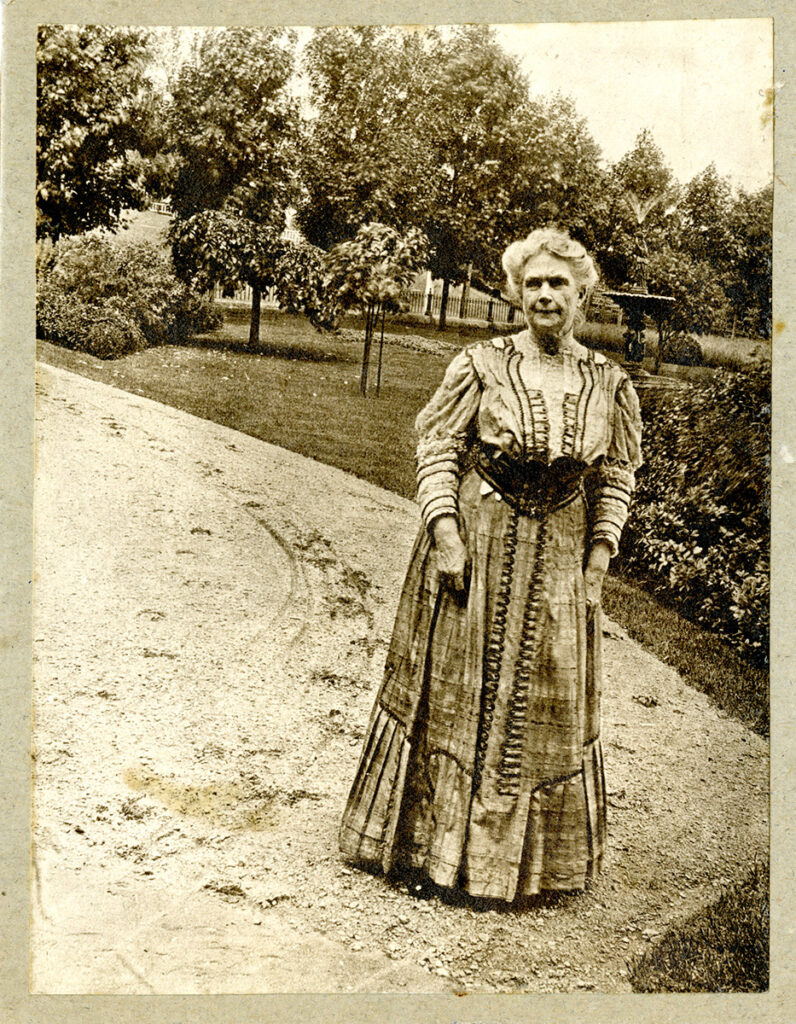 Sarah Jane Clark, c. 1907. Photographer unknown. P00464.
Sarah Jane Clark, c. 1907. Photographer unknown. P00464.
Eddy knew the growing necessity for experienced Christian Scientists to support the fledgling Midwestern groups. “It is highly important that students from [MMC] should be distributed in every state of the Union,” she wrote to Clark. “I am not satisfied with some teaching even if the work moves on, it has a wrong impulse.”18 In the “Call to the ministry” section, an appeal for volunteers appeared in the October 1886 Journal: “There is a great need now of earnest and competent men and women as pastors and missionary preachers, whose hearts God has touched, inspiring them to feel that this is their vocation.”19
One man who answered the missionary call was Edward Hammond. Originally from Massachusetts, he was an experienced Journal-listed practitioner and teacher who had taken Primary class from Eddy in 1883. His first Journal article, published in 1885, compared the radical stand of Christian Science with the writing of the Magna Carta, Martin Luther’s break from the Catholic church, and the abolitionist movement. He argued that Christian Science would, in its radicalism, emerge victorious over “mortal error.”20
Hammond had a successful healing practice in Massachusetts,21 when he first received a request from Ellen Brown Linscott of Chicago to relocate to the city of Grand Rapids in western Michigan.22 Linscott had recently traveled to Grand Rapids, where she found such enthusiastic interest in Christian Science that a healing “testimonial” by one resident had been used in an advertisement for the 1885 printing of Science and Health.23 With her own students in Chicago to support, Linscott couldn’t stay there. But she was reluctant to leave the area without a replacement to teach the growing list of individuals desiring instruction from an MMC graduate. While this interest was very encouraging, Linscott recognized that without the guidance of an experienced Christian Scientist, this interest could easily be commandeered by “mind healers” teaching an unauthorized, inaccurate version of Christian Science—a version that was causing confusion and disruption throughout the Midwest at the time.24
When Hammond received Linscott’s urgent request for help in November 1885, he was lecturing on Christian Science twice a week in Washington, D.C. With the news that a class was already awaiting him in Grand Rapids—and that if he didn’t hurry the students would be lost to the “opposition”—Hammond promptly traveled to Chicago and the next day relocated to Grand Rapids, where he taught the class that very evening.25 Linscott gratefully reported to Eddy, “Mr Hammond is full of work in Grand Rapids, and will organize there. He must.”26
Like many Christian Science missionaries in the Midwest, Hammond rapidly established himself through lectures, chats with church leaders, social talks, healing work, meetings with local physicians, newspaper interviews, and efforts to support his new students. Recognizing the need to stay in Grand Rapids indefinitely, in order to stabilize the growing movement, he wrote this in a letter to Eddy:
I believe in planting the pure science of Christianity on a firm & solid basis now that I am here & not leave my work half done. I have seen enough in the East of mental healers stopping at a place a few days or a few weeks, gathering up a few dollars & then leaving never to be seen again. Such people are too apt to leave a desert behind them. I am going to get these people my pupils to work, I am demonstrating every day & when I leave this place this Christian Science shall be planted & rooted to remain.27
Eddy applauded Hammond’s efforts and expressed gratitude for his willingness to stay put in Grand Rapids:
You know I have pled with my students to do this, and you have opened the way, I trust, for others to follow your leadings. The West is a glorious field for this labor …. May God bless you wherever you labor, stay your hands, uphold your efforts, and reward your fidelity. He will[.] Let me hear from you again.28
Hammond did keep in touch with Eddy, though at points apologizing for his tardy replies and explaining that his busy healing practice, full teaching schedule, and lecture engagements meant “I am so much on the jump day & evening I have scarcely seen the time.”29 In one spare moment, Hammond told Eddy of a child’s healing that “filled [him] with awe & the community with wonder.”30 Local testimonies of healing were soon featured in the Journal.31 As the religion gained traction, the city’s newspaper published a complimentary account of the local Christian Scientists, describing converts as “well-known business men, whose shrewdness and good horse sense are undoubted, and of equally well-known ladies, whose standing in social, literary, art, and musical circles is of the very highest ….”32 About the religion itself, the article stated, “There are portions of the Christian Science doctrine which seem past belief when first heard, but it is a noteworthy fact that in this case unprejudiced investigation is always followed by respect, and in many cases by belief.”33
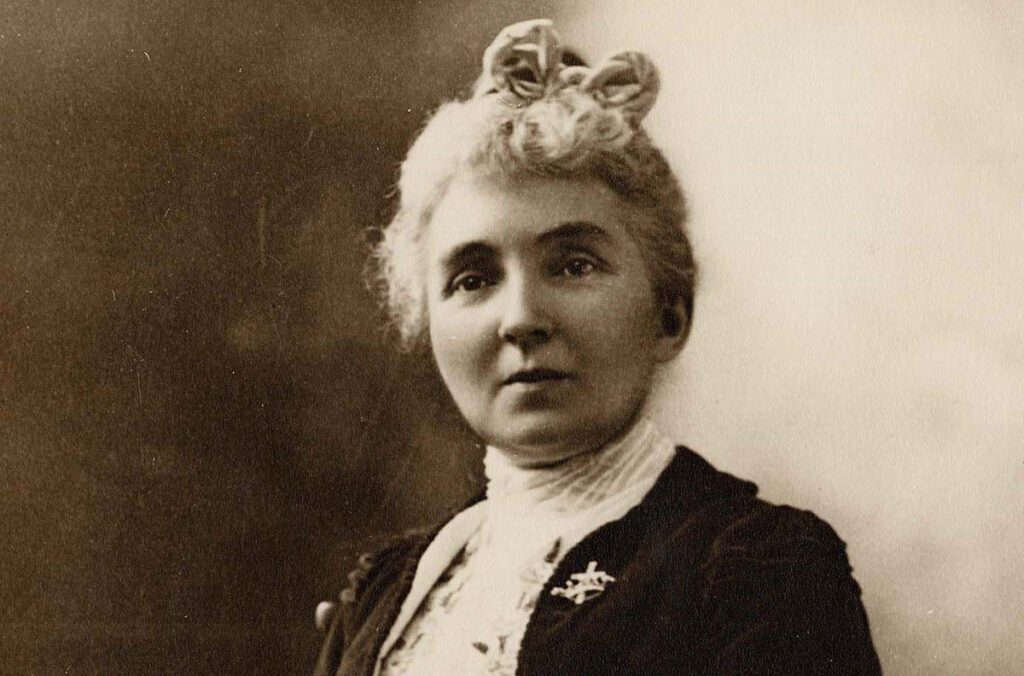 Portrait of Annie M. Knott, circa 1898. P01068. Photographer unknown.
Portrait of Annie M. Knott, circa 1898. P01068. Photographer unknown.
As interest in and respect for Christian Science grew in Michigan, along with the number of its followers, the need for Christian Science church services became apparent. In 1889 Eddy asked Hammond and another of her trusted students, Annie Knott of Detroit, to assist in starting Sunday services in the state. These began in both Detroit and Grand Rapids in 1889, continuing to spring up throughout Michigan.34
In an 1890 Journal article, Hammond shared a helpful insight from his successful efforts to establish Christian Science in the Grand Rapids community:
I do not, as some do, fear to place this wonderful book (Science and Health) in the hands of everyone. I have followed this plan for the last five years with the best results. Students need not fear the world is not ready for it. They are ready for it. The light has come, and there are open eyes to receive it. During the last five years, I never have had but one Science and Health returned to me.35
Though Hammond moved to Baltimore in 1894, the good soil he nurtured in Grand Rapids for almost a decade continued to bear impressive fruit. The church there hosted a lecture in 1898, the inaugural year of the Christian Science Board of Lectureship. The monthly Journal and the weekly Christian Science Sentinel continued to publish evidence of Christian Science development in Grand Rapids, evident in a collection of letters from grateful students of the growing Sunday School. One little girl, whose mother was healed of a disease doctors had deemed terminal, wrote, “My sister says that she doesn’t know how people lived before Christian Science was discovered.”36 In a group of letters published in the Sentinel, a Grand Rapids resident gave gratitude for the introduction of the magazine, stating that it would “feed and nourish the hungry children while [they wait] each month for the next Journal, for the time to most of us I know seems long.”37
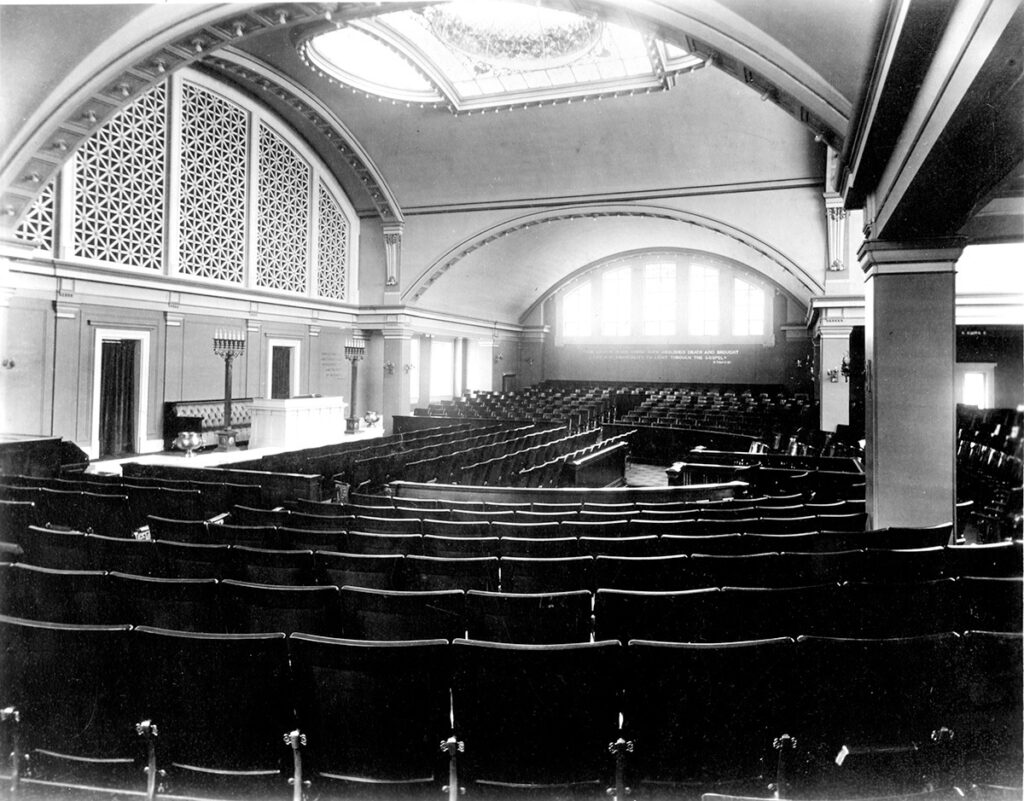 Interior of First Church of Christ, Scientist, Grand Rapids, Michigan, circa 1906. Church Archives, Box B530759, Folder F232943. Photographer unknown.
Interior of First Church of Christ, Scientist, Grand Rapids, Michigan, circa 1906. Church Archives, Box B530759, Folder F232943. Photographer unknown.
Indicating the level of respect that Christian Scientists and their religion garnered in the Grand Rapids community, the local Evening Press newspaper reached out to Eddy in 1907. “What is nearest and dearest to your heart to-day?” they asked. Before printing her reply, the paper described her as “the most discussed woman in all the world,” and commented on her “sweet smile” and “world-wide renown.” The editor then stated that her answer would “be read with deep interest by all Americans, who, whatever their religious beliefs, cannot fail to be impressed by the personality of this remarkable woman.”38
By the start of the twentieth century, this “remarkable woman,” and the church she founded, had gone from obscure and unknown to nationally recognized and respected. This was in no small measure thanks to the determination, devotion, and achievements of local and relocated Midwestern Christian Scientists. Though their work was hard, the reward was for them “Life’s pearl.” Like the many individuals in need of help and healing during this era, Michiganders’ letters show that those who sought out Eddy and her teachings often found the restored health and spiritual uplift they so desired. For these new Christian Scientists, the closing lines of Barlow’s poem likely describe their rejuvenated sense of life:
Then rise and greet the signs that prove
Unreal the ages’ long lament;
The “one far-off divine event”
Is now, and that event is Love.39
Elise McCurties has a PhD in American history and was a history professor at Principia College for seven years. She currently freelances for various Christian Science organizations and travels with her husband, Mark, who is a member of the Christian Science Board of Lectureship.
- Charles H. Barlow, “Thy Word is Nigh,” The Christian Science Journal, July 1888, 215, https://journal.christianscience.com/issues/1888/7/6-4/thy-word-is-nigh; Christian Science Hymnal (Boston: The Christian Science Publishing Society, 1932), No. 391.
- The sample size of letters for this study was from 60 Michiganders, written from 1885 to 1886, and another 30 letters from the 1880s that specifically related to the development of Christian Science in Michigan.
- Mary Baker Eddy to Katie Swarts, 30 September 1884, V00838 (Swarts was born in Michigan but was living in Illinois when she and Eddy began to have contact); A.M. Smith to Mary Baker Eddy, 23 June 1885, 712AP1.85.006; Nellie Gates to Mary Baker Eddy, 16 March 1885, 670B.73.014; D.M.
- Ellen Brown Linscott to Mary Baker Eddy 6 February 1886, 163A.27.041; Ellen Brown Linscott to Mary Baker Eddy 30 December 1885, 163A.27.037; Silas J. Sawyer to Mary Baker Eddy 20 April 1885, 237AP2.38.004; Silas J. Sawyer to Mary Baker Eddy, 5 February 1886, 237AP2.38.014; Sarah J. Clark to Mary Baker Eddy, 16 March 1885, 050.15.001; Sarah J. Clark to Mary Baker Eddy, 27 May 1885, 050.15.002; Sarah J. Clark to Mary Baker Eddy, 29 July 1885, 050.15.003; Sarah J. Clark to Mary Baker Eddy, 17 August 1885, 050.15.004; Sarah J. Clark to Mary Baker Eddy, 18 August 1885, 050.15.005; Martha E. Sherman to Mary Baker Eddy, 1 December 1885, 321.44.076. Mary Baker Eddy Library; For more information about missionary work please see, “What is the history of missionaries in Christian Science?” https://www.marybakereddylibrary.org/research/what-is-the-history-of-missionaries-in-christian-science/
- Martha P. Kelly to Mary Baker Eddy, 8 February 1884, 684A.77.038; Julius Ashman to Mary Baker Eddy, 23 October 1883, 643A.66.030; J.A. Vickers to Mary Baker Eddy, 19 August 1885, 720B.88.004; Sarah B. Bestor to Mary Baker Eddy, 7 March 1886, 647.67.053; Jennie M. Joy to Mary Baker Eddy 8 February 1886, 683B.77.072; Anna M. Steinmann to Mary Baker Eddy, 20 December 1884, 346.47.004; Mrs. D.M. Fleming to Mary Baker Eddy, 26 January 1885, 668A.73.003; Ezra G. Goddard to Mary Baker Eddy, 19 April 1886, 672A.73A.003; Delia D. Trego to Eddy, 8 March 1885.
- Martha E. C. Bates to Mary Baker Eddy, 17 March 1885, 645B.66.028, https://mbepapers.org/?load=645B.66.028
- Eugene B. Weeks to Mary Baker Eddy, 1 August 1885, 722A.89.037; Anna M. Steinmann to Mary Baker Eddy, 10 January 1886, 346.47.005; Nancy A. Evans to Mary Baker Eddy, 7 July 1885, 666B.72.043; Delia Robb to Mary Baker Eddy, 15 August 1885, 706B.84.011; Ellen J. Carter to Mary Baker Eddy, 9 April 1885, 655.69.046; Almeda Bell to Mary Baker Eddy, 5 March 1886, 646B.67.011.
- Mattie Bowen 5 August 1885, 482.55.035, https://mbepapers.org/?load=482.55.035
- Jennie M. Joy to Mary Baker Eddy 8 February 1886, 683B.77.072; Mary Baker Eddy to Sarah J. Clark, 10 August 1885, L04021
- Mattie Bowen to Mary Baker Eddy, 27 October 1885, 482.55.037, https://mbepapers.org/?load=482.55.037
- Mattie Bowen to Eddy, 27 October 1885, 482.55.037, https://mbepapers.org/?load=482.55.037
- Mattie Bowen to Mary Baker Eddy, 1 November 1885, 482.55.038, https://mbepapers.org/?load=482.55.038
- E.C. Campbell, “Spring Months,” Journal, April 1887, 41, https://journal.christianscience.com/issues/1887/4/5-1/spring-months; H.P.C., “Mrs. Eddy I wish to testify ….” Journal, January 1887, 260, https://journal.christianscience.com/issues/1887/1/4-10/mrs.-eddy-i-wish-to-testify-through-the
- Sylvia W. Cook to Mary Baker Eddy, 29 April 1886, 941.91.081, https://mbepapers.org/?load=941.91.081
- “Notes from the Field,” Journal, February 1891, 495, https://journal.christianscience.com/issues/1891/2/8-11/notes-from-the-field
- Alice A. Bigelow to Mary Baker Eddy, 19 October 1884, 648A.67.004, https://mbepapers.org/?load=648A.67.004
- Sarah J. Clark to Mary Baker Eddy, 16 March 1885, 050.15.001, https://mbepapers.org/?load=050.15.001
- Mary Baker Eddy to Sarah J. Clark, 24 August 1885, L10805, https://mbepapers.org/?load=L10805
- “Call to the Ministry,” Journal, October 1886, 173, https://journal.christianscience.com/issues/1886/10/4-7/call-to-the-ministry
- Edward H. Hammond, “Is it too Radical,” Journal, February 1885, 5-6, https://journal.christianscience.com/issues/1885/2/2-15/it-is-too-radical
- William T. Seaver to Mary Baker Eddy, 29 October 1883, 506.56.038
- Edward H. Hammond to Mary Baker Eddy, 15 December 1885, 075.18.002; Ellen Brown Linscott to Mary Baker Eddy, 30 December 1885, 163A.27.037; Ellen Brown Linscott to Mary Baker Eddy, 6 February 1886, 163A.27.041
- Silas J. Sawyer to Mary Baker Eddy, 20 April 1885, 237AP2.38.004
- Ellen Brown Linscott to Mary Baker Eddy, 30 December 1885, 163A.27.037; Ellen Brown Linscott to Mary Baker Eddy, 31 January 1886, 163A.27.038; Emily P. Billings to Mary Baker Eddy, 6 June 1885, 648A.67.018; A.J. Swarts to Calvin Frye, 8 October 1885, 952.93.050; A.J. Swarts to Mary Baker Eddy, 18 November 1885, 579.59.013; A.J. and Katie Swarts to Mary Baker Eddy, 20 December 1885, 579.59.027; A.J. Swarts to Calvin Frye, 27 August 1885, 952.93.048; Ann M. Otis to Mary Baker Eddy, 2 April 1885, 360.48.001; Richard Pengelly to Mary Baker Eddy, 29 September 1885, 701B.82.007; Sarah J. Clark to Mary Baker Eddy, 17 August 1885, 050.15.004
- Edward H. Hammond to Mary Baker Eddy, 15 December 1885, 075.18.002, https://mbepapers.org/?load=075.18.002
- Ellen Brown Linscott to Mary Baker Eddy, 6 February 1886, 163A.27.041, https://mbepapers.org/?load=163A.27.041
- Edward H. Hammond to Mary Baker Eddy, 15 December 1885, 075.18.002, https://mbepapers.org/?load=075.18.002
- Mary Baker Eddy to Edward H. Hammond, 24 December 1885, L04551, https://mbepapers.org/?load=L04551
- Edward H. Hammond to Mary Baker Eddy, 3 May 1886, 075.18.004, https://mbepapers.org/?load=075.18.004
- Edward H. Hammond to Mary Baker Eddy, 1 March 1886, 075.18.003, https://mbepapers.org/?load=075.18.003
- Mrs. K.B.H., “My little boy…,” Journal, December 1889, 475 https://journal.christianscience.com/issues/1889/12/7-9/my-little-boy-three-years-old-was-attacked-in-the-night-with
- “Not to be Ridiculed,” The Grand Rapids Democrat, as republished in the Christian Science Sentinel, 26 January 1899, 14 https://sentinel.christianscience.com/issues/1899/1/1-22/miscellany
- Another example of public support for the upstanding character of Christian Scientists appears in a letter published in the Journal, written by a an attorney-at-law in Charlevoix, Michigan, to a “Mrs. M. A. E., C.S.” See “The following letter is interesting as showing the fact…,” Journal, August 1897, XX. https://journal.christianscience.com/issues/1897/8/15-5/the-following-letter-is-interesting-as-showing-the-fact
- Annie Knott Reminiscence, Mary Baker Eddy Library; “Among the Churches,” Sentinel, 3 November 1906, 161. See also Eddy’s telegram to First Church of Christ, Scientist, Detroit, Eddy, The First Church of Christ, Scientist, and Miscellany (Boston: The Christian Science Board of Directors), 183.
- Edward Hammond, “Notes from the Field,” Journal, April 1890, 28, https://journal.christianscience.com/issues/1890/4/8-1/notes-from-the-field
- Genevieve Utley, 16 June 1897 letter in “Letters to Mrs. Eddy,” Journal, August 1897, 302 https://journal.christianscience.com/issues/1897/8/15-5/letters-to-mrs.-eddy
- “The Weekly,” Sentinel, 22 September 1898, 4 https://sentinel.christianscience.com/issues/1898/9/1-4/the-weekly
- “Mrs. Eddy Describes Her Human Ideal,” The Evening Press, August 1907; Eddy, Miscellany, 271.
- Barlow, “Thy Word is Nigh,” Journal, July 1888, 215 https://journal.christianscience.com/issues/1888/7/6-4/thy-word-is-nigh
